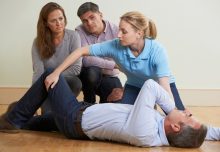Top 5 sports injuries and how to treat them
The Olympics is now in full swing. Though we’re as excited about it as the rest of Britain, we’re also a First Aid training company, so we can’t help but think about all the health risks involved. Over 10,000 athletes take part so we’re afraid to say there’s likely to be a large amount of injuries. Even more when you consider the millions of fans attending the games who might injure themselves while attending or more likely afterwards due to some misguided Olympics inspired act of athleticism. It’s no surprise that each games requires up to 5000 voluntary medical staff to help out during the event!
So what are the most common injuries that are likely to occur? Here’s our Top 5, with some useful tips on how to treat each one.
1. Runner’s knee
Knee injuries account for over 50% of sports injuries. Many are diagnosed as ‘Runner’s knee’, referring to pain behind or around the kneecap. It typically occurs due to excessive strain placed on the knee and surrounding tissues.
How to treat an injured knee?
Rest and time! Ice or compression treatments and stretching may help recovery. Severe cases may need surgery.
2. Shoulder injury
Injuries to the shoulder make up over 20% of sports injuries, this could be a dislocation, a sprain or strain. A shoulder injury is particularly likely to occur in sports which require movement of the arms above the head like tennis and swimming.
How to treat shoulder injuries?
Rest as much as you can. Stretching exercises recommended by a professional should help too.
3. Sprained Ankle
An sprained ankle is caused by an injury to the ligaments connecting the legs to the foot. It typically occurs when an ankle is twisted or turned in an awkward way.
How to treat a sprained ankle?
Rest, ice or compression treatments can help. Ankle supports or footwear can hold the ankle firmly in place and prevent further injury.
4. Tennis elbow
Tennis elbow is caused by excessive strain on the forearm muscles and tendons immediately below the elbow. This often happens when playing tennis, as the name suggests but also in sports like golf and activities like DIY.
How to treat tennis elbow?
Fortunately tennis elbow will get better in time regardless of treatment. But rest and a cold compress should alleviate the symptoms.
5. Pulled hamstring
This is the first injury that springs to mind when we think of the Olympics, especially in the hurdle and sprint events. A pulled hamstring occurs when an athlete overuses or stretches the muscle (actually 3 different muscles) behind the knee.
How to treat a pulled hamstring?
Unfortunately hamstrings take a long time to heal, up to 12 months. Rest and gentle stretches are advised as well as ice and anti-inflammatory medication.
So now you know what injuries to look out for. Let’s hope none of our British athletes are afflicted!





